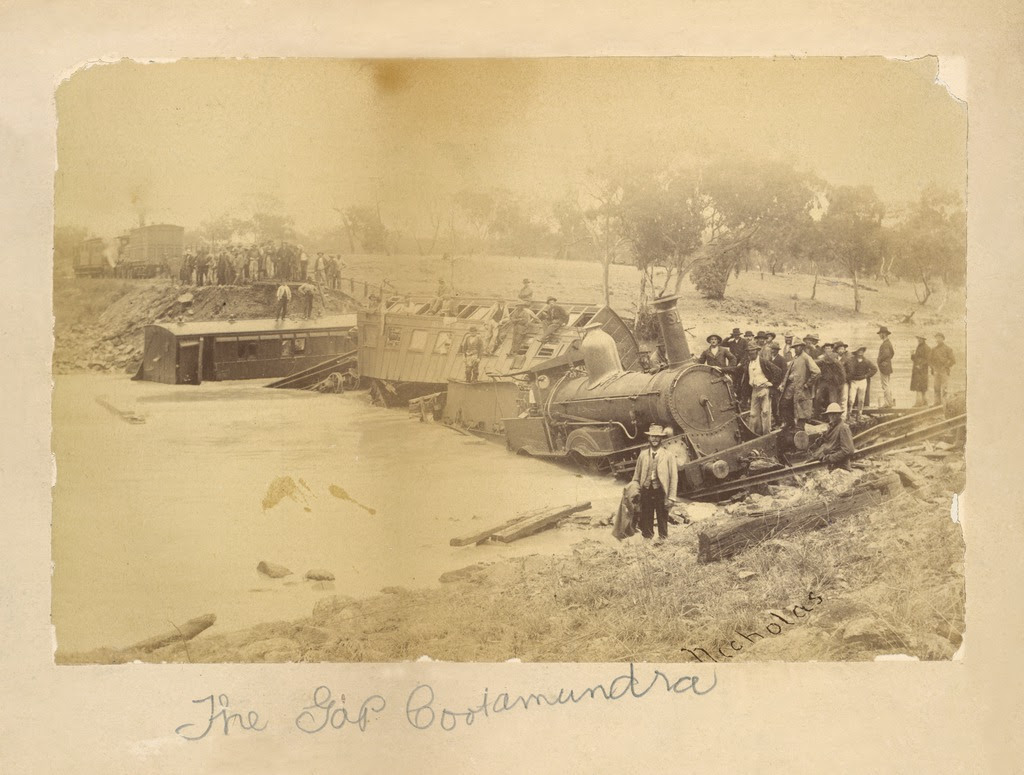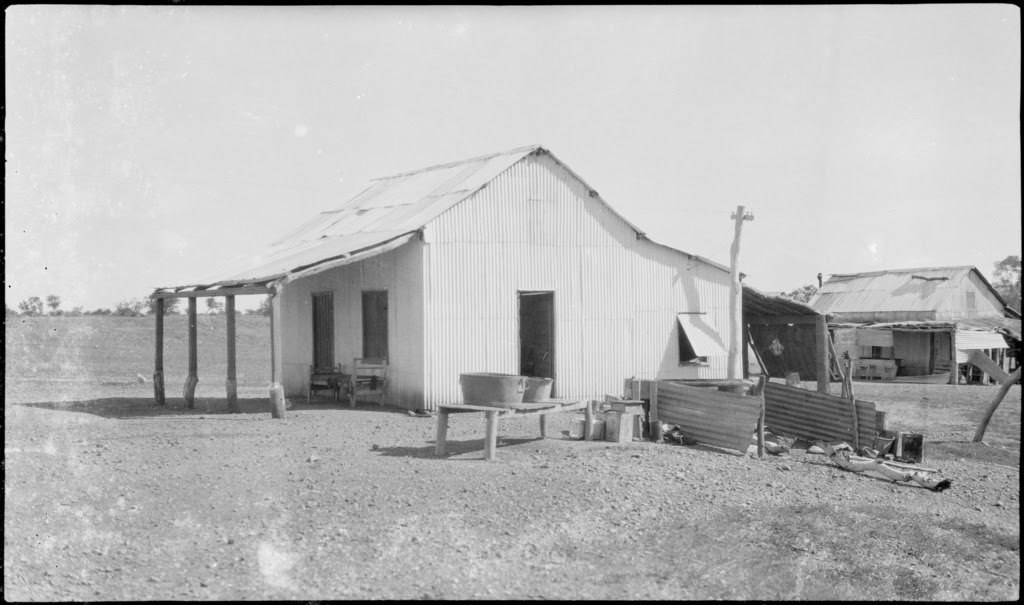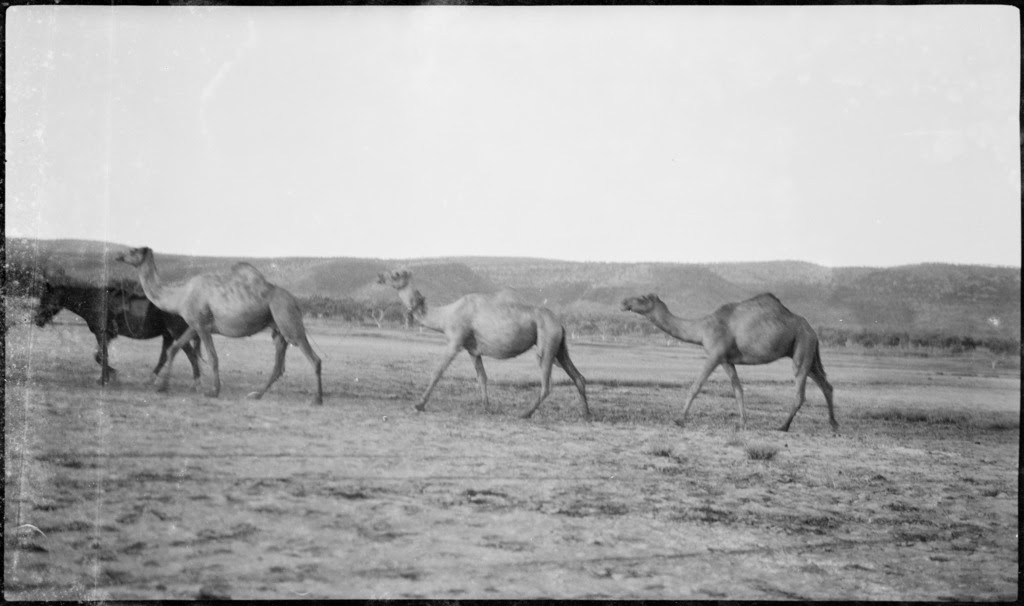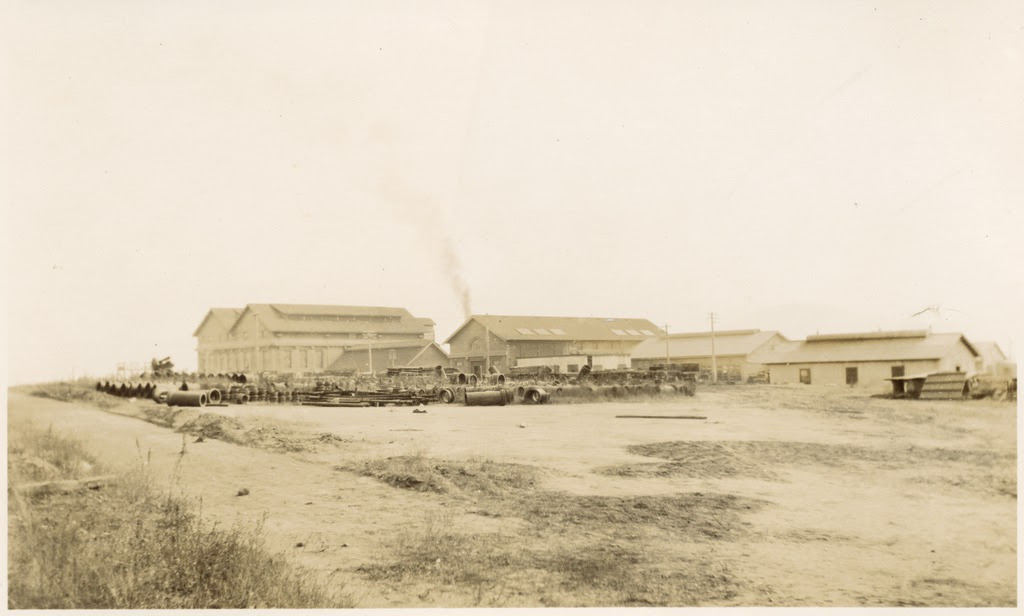.

Notice on Mount Bundy Station prohibiting shooting beyond sign, Northern Territory: photographer unknown, 1945, in Survey into possibilities of pursuing buffaloes in North Australia for export to liberated Far Eastern countries by Major Granger and Captain Peisley, Northern Australia, May-June 1945 (National Library of Australia)

Panoramic view of the main street in Katoomba, New South Wales: photo by EB Studios (Sydney, N.S.W.), 1920 (Enemark collection of panoramic photographs, National Library of Australia)

Panorama of Rose Bay bakery, Rose Bay,, New South Wales: photo by EB Studios (Sydney, N.S.W.), 1920 (Enemark collection of panoramic photographs, National Library of Australia)

Francis Birtles' bicycle and a thirst victim's grave in central Australia: photo by Francis Birtles, c. 1899 (Francis Birtles motor car tour collection, c. 1899-1927, National Library of Australia)

Two dolls with a potted cactus, Cuppacumbalong, Australian Capital Territory: photographer unknown, c. 1893 (De Salis, Farrer and Champion families photograph collection, Australian Capital Territory and New South Wales, National Library of Australia)

Mascot on radiator cap: photo by Francis Birtles, c. 1899 (Francis Birtles motor car tour collection, c. 1899-1927, National Library of Australia)

Wrecked engine from an R.E.8 aeroplane, France (likely to be an RAF-4, built by the Royal Aircraft Factory): photo by John Michael Joshua) (1893-1974), 1918 (John Joshua collection of World War 1 aviation photographs, 1915-1918, National Library of Australia)

Overturned train engine of the Brisbane Limited that crashed at Aberdeen, New South Wales: photographer unknown, 10 June 1926 (National Library of Australia)

Rescue crew clear wreckage surrounding the crashed Brisbane Limited, Aberdeen, New South Wales: photographer unknown, 10 June 1926 (National Library of Australia)

The Melbourne-Sydney
passenger train derailed at The Gap, Salt Clay Creek, near Cootamundra,
New South Wales: photo by William A. Nicholas or George H. Nicholas, photographers at Cootamundra, Cowra, Bundanoon, 25 January 1885 (National Library of Australia)

Group of Aboriginals at Chowilla Station on the lower Murray River, South Australias: photo by Charles Bayliss (1850-1897), 1886, in Views of
scenery on the Darling and Lower Murray during the flood of 1886 (National Library of Australia)

The water tower and waterworks at Wilcannia on the Darling River, New South Wales: photo by Charles Bayliss (1850-1897), 1886, in Views of
scenery on the Darling and Lower Murray during the flood of 1886 (National Library of Australia)

The dust storm is coming, early Broken Hill: photo by Ion Llewellyn Idriess (1890-1979), n.d. (Ion Idriess glass plate negative collection, National Library of Australia)

Sheet iron building at homestead, Flora Valley, Western Australia, during search by Les Holden in de Havilland DH61 Giant Moth biplane for Charles Kingsford-Smith and crew after the Southern Cross was forced to land in North-West Australia: photo by Norman Ellison, 19 April 1929 (Norman Ellison Collection of Australian 1920's aviation search and rescue activities, aerial views and people, 1914-1970, National Library of Australia)

Aerial view of small outback settlement [almost certainly Alice Springs, with Heavitree Gap and the Todd River visible in the background], Western Australia, during search by Les Holden in de Havilland DH61 Giant Moth biplane for Charles Kingsford-Smith and crew after the Southern Cross was forced to land in North-West Australia: photo by Norman Ellison, April 1929 (Norman Ellison Collection of Australian 1920's aviation search and rescue activities, aerial views and people, 1914-1970, National Library of Australia)

Aerial view of outback, Western Australia, during search by Les Holden in de Havilland DH61 Giant Moth biplane for Charles Kingsford-Smith and crew after the Southern Cross was forced to land in North-West Australia: photo by Norman Ellison, April 1929 (Norman Ellison Collection of Australian 1920's aviation search and rescue activities, aerial views and people, 1914-1970, National Library of Australia)

Small crowd with truck examining
Les Holden's de Havilland DH61 Giant Moth biplane airliner G-AUHW
'Canberra' on a field, Alice Springs, Northern Territory, during search by Les Holden for Charles Kingsford-Smith and crew after the
Southern Cross was forced to land in North-West Australia: photo by Norman Ellison, 7 April 1929 (Norman Ellison Collection of Australian
1920's aviation search and rescue activities, aerial views and people,
1914-1970, National Library of Australia)

Three camels walking across plain, Wyndham, Western Australia, during search by Les Holden in de Havilland DH61 Giant Moth biplane for Charles Kingsford-Smith and crew after the Southern Cross was forced to land in North-West Australia: photo by Norman Ellison, 19 April 1929 (Norman Ellison Collection of Australian 1920's aviation search and rescue activities, aerial views and people, 1914-1970, National Library of Australia)

Panorama of the site for Canberra taken from Mt. Ainslie. Landmarks and sites for future buildings handwritten in ink on image: "Queanbeyan Rd., Red Hill, Stromlo, Parliament House, St. John's Church, Molongolo River, Hotel Canberra, Acton House, Civic Centre, Black Mountain": photo by Frank H. Boland (d. 1955), c. 1910 (National Library of Australia)

Panorama of Canberra before the construction of buildings in the Northbourne Avenue, Ainslie Avenue area. Taken from Civic Centre showing Terrace Avenue on the left, Northbourne Avenue centre, Ainslie Avenue to right: photo by Frank H. Boland (d. 1955), c. 1920 (National Library of Australia)

Canberra Power House (1926 tour): photo by Charles Henry Taylor (1900-1984), 13 March 1926 (collection of photographs of Canberra before the
official opening of Parliament House by Henry Taylor, National Library of Australia)

Sheep near Parliament House [Canberra]: photo by Albert R. Peters (d. 1969). c. 1940 (National Library of Australia)

Unidentified woman seated outdoors on a rug with tea set and books: photo by Sir Lionel Lindsay (1874-1961), c. 1906 (Sir Lionel Lindsay collection of photographs of family and friends, c. 1880-c. 1960, National Library of Australia)

Portrait of Norman and Daryl Lindsay: photo by Sir Lionel Lindsay (1874-1961), c. 1920 (Sir Lionel Lindsay collection of photographs of family and friends, c. 1880-c. 1960, National Library of Australia)

Josephine Smith digging a grave at the Drouin Cemetery, Victoria (1). Label: "Meet Mrs. Josephine Smith, aged 84, whose hobby is digging graves. She lives in Drouin, a typical little farming town (1100 people), in southern Australia, 60 miles out of the Victorian capital, Melbourne. ...": photo by Jim Fitzpatrick (1916-), 1944 (collection of photographs of Drouin town and rural life during World War II, National Library of Australia)

Josephine Smith digging a grave at the Drouin Cemetery, Victoria (2). Label: "Meet Mrs. Josephine Smith, aged 84, whose hobby is digging graves. She lives in Drouin, a typical little farming town (1100 people), in southern Australia, 60 miles out of the Victorian capital, Melbourne. ...": photo by Jim Fitzpatrick (1916-), 1944 (collection of photographs of Drouin town and rural life during World War II, National Library of Australia)

Portrait of Leah Notman, Drouin, Victoria. Label: " Leah Notman is a Drouin farmers's daughter. She plays the piano at the local dances and helps her mother with the housework. She has three brothers; no sisters. Her boyfriend drives a big milk truck; she usually goes with him for a drive in the truck on his Saturday afternoon circuit.": photo by Jim Fitzpatrick (1916-), 1944 (collection of photographs of Drouin town and rural life during World War II, National Library of Australia)

William Russell putting the four gallon monthly ration of petrol into a customer's car, Drouin, Victoria. Label: "Home town Australia. Drouin's biggest service station (there are two) is owned by a company consisting of 80 year old William D. Russell and his family. Mr Russell is putting the four gallon monthly ration of gas onto a customers car. Normally he employs 16 ... Sign is for the benefit of United States servicemen using the Princes Highway ...": photo by Jim Fitzpatrick (1916-), 1944 (collection of photographs of Drouin town and rural life during World War II, National Library of Australia)

Mrs Searle standing beside a road sign, London Circuit, Canberra: photo by Edward William Searle (1887-1955), c. 1949 (E.W. Searle collection of photographs, National Library of Australia)
Tom,
ReplyDeleteThese are some striking images..the mascot on a radiator cap is quite odd..it interrupts the usual consumption of an image..and it is only early days in Brazil..but got any favourites tom? Non-footballing matters aside
Manik, when convalescing from a bout of rheumatic fever as a wee lad I was allowed to achieve year's advancement in school if I would undertake a serious scholastic project. With diligent industry I battled all manner of challenges, fevers, hallucinations & c. to complete a longish essay on Australia (all aspects). To this day I associate Australia with long illness and probably always shall.
ReplyDeleteMore "objectively" speaking, however, I think it may be safe to say the Aussies are a historically flamboyant lot, if their radiator cap mascots are any sort of measure.
But shoving the wonders of Australia, the sheep by the Parliament House and all, aside for the moment... from what I've been able to pick up so far (dodgy streams, frantic Spanish language radio broadcasts), this has already been the most interesting and lively World Cup of the present otherwise untenable millennium. That's all to do with South America, I can't help thinking.